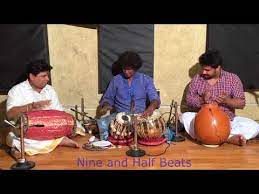
"Ghatam and Tabla: Rhythmic Pottery and Percussive Poetry"
In the symphony of percussion instruments, the Ghatam and Tabla stand as iconic vessels of rhythm and melodic resonance. These instruments, deeply rooted in cultural heritage and artistic finesse, embody the rich tapestry of Indian percussion, each with its distinct tonality, techniques, and cultural significance. Let's embark on a rhythmic expedition to unravel the craftsmanship, rhythmic intricacies, cultural significance, and melodic allure of the Ghatam and Tabla.
Ghatam: The Earthy Rhythmic Melodist
Historical Heritage:
Originating from South India, the Ghatam embodies a legacy rooted in pottery-making traditions. Crafted from clay and adorned with rhythmic patterns, it resonates as an ancient vessel transformed into a musical instrument.
Design and Technique:
The Ghatam's unique design, with a wide belly and narrow mouth, allows for a broad range of tonalities—from deep bass to crisp trebles. Percussionists employ fingers, palms, and intricate hand movements to create a mesmerizing array of rhythms and beats.
Cultural Significance:
The Ghatam's association with temple rituals, classical concerts, and folk music makes it an integral part of South Indian percussion ensembles, symbolizing cultural heritage and rhythmic finesse.
Tabla: The Percussive Maestro of North India
Historical Evolution:
The Tabla, originating from North India, reflects a synthesis of Persian, Central Asian, and indigenous influences. Its pair of drums—'Dayan' (treble) and 'Bayan' (bass)—creates a dynamic interplay of tones and rhythms.
Technique and Artistry:
Tabla players exhibit virtuosity through intricate finger movements, 'bols' (syllabic patterns), and 'taals' (rhythmic cycles). The instrument's tunable nature allows for a wide range of tonal variations and melodic expressions.
Cultural Significance:
The Tabla's prominence in Hindustani classical music, its role as a solo instrument and accompaniment to vocalists and instrumentalists, cements its position as a cultural ambassador and rhythmic anchor in North Indian musical traditions.
Percussive Unity, Cultural Diversity
While the Ghatam and Tabla hail from different regions and reflect diverse cultural influences, they share a common ethos—their ability to communicate emotions, narrate stories, and create rhythmic landscapes through their resonant beats.
Conclusion: Percussive Dialogues, Melodic Conversations
As the Ghatam's earthen rhythms entwine with the Tabla's vibrant beats, they illustrate the harmonious dialogue between percussion traditions. Both instruments, with their distinct timbres and rhythmic complexities, epitomize the rhythmic poetry and cultural heritage embedded in Indian percussion.
Their beats echo through classical concerts, cultural gatherings, and collaborative performances—a testament to the rhythmic elegance, melodic versatility, and enduring allure of the Ghatam and Tabla in the vast symphony of Indian music.
The Ghatam and Tabla, with their unique tones and rhythmic intricacies, encapsulate the rich cultural heritage and artistic finesse of Indian percussion, uniting diverse traditions through their rhythmic poetry and melodic resonance.
ABOUT AUTHOR : Musicintuit Admin
EXPLORE OUR ARRAY OF ONLINE MUSIC COURSES: Musicintuit Courses
ENROLL TODAY ! EXPLORE AND IMMERSE YOURSELF IN THE REALM OF MUSIC: Contact Musicintuit




